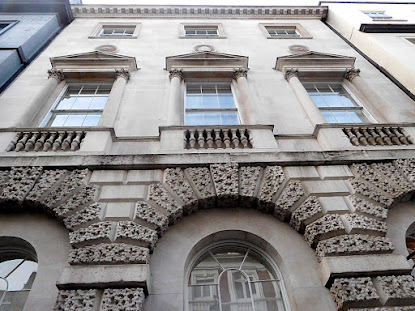The
architectural historian, Nikolaus Pevsner (1908-1983), whose writing I enjoy
greatly, is a little dismissive of the buildings in Dover Street with one
exception. In his “London Volume 1”, which was co-authored by Bridget Cherry,
he wrote of this street:
“The
only house which needs special attention is Ely House (No. 37)”
This
is the building that is now home to Thaddeus Ropac. Ely House was built in the 1770s
by the then Bishop of Ely, Edmund Keene (1714-1781), who was appointed to that
post in January 1771. According to The Dictionary of National Biography (1885-1900
edition), Keene:
“…
obtained in 1772 an act of parliament for alienating from the see, in
consideration of the payment of 6,500l. [i.e., £6,500] and an annuity of 200l.,
the ancient palace in Holborn, and for purchasing, at a cost of 5,800l., the
freehold of a house in Dover Street, Piccadilly, London. The present house on
that site was built by him about 1776.”
Clearly,
the bishop was not short of cash; he was married to Mary (née Andrews), daughter
and sole heiress of Andrews of Edmonton, once a successful linen draper in
Cheapside.
The
architect of Ely House was Sir Robert Taylor (1714-1788). The building remained
the London residence of the Bishops of Ely until the beginning of the 20th
century. In 1909, the interior of Ely House was greatly modified by the Arts
& Crafts architectural firm Smith and Brewer (https://ropac.net/news/245-galerie-thaddaeus-ropac-ely-house-london/),
and it became the home of The Albermarle Club. This private members’ club,
founded in 1874, was open to both men and women, and was first housed at 13 Albermarle
Street. Known for its liberal views on women’s rights, it was in 1895 the site
of an incident that led to the first trial of one of its members, the writer
Oscar Wilde (www.back2stonewall.com/2021/02/gay-lgbt-history-feb-18-oscar-wilde-accused-sodomite.html).
Because of the club’s connection with proceedings that led to Wilde’s downfall,
it moved to 37 Dover Street to distance itself from Albermarle Street where these
unfortunate events had occurred.
During
WW2, Ely House became used by The American Red Cross Interstate Club. Later, it
housed a private bank. When Pevsner and Cherry published their book in 1973,
the house was being used by Oxford University Press. In Spring 2017, Thaddeus
Ropac announced that they would open their London gallery in Ely House.
The
exterior of Ely House might not have changed much since it was constructed. A
medallion on the façade depicts a bishop’s mitre. The magnificent wrought iron
railings topped with several models of lions was a 19th century
addition based on the lions designed for The British Museum by the sculptor
Alfred Stevens (1817-1875). The interior of Ely House would now be
unrecognisable to Bishop Edmund Keene apart from a few decorative features that
have been preserved. Furthermore, the artworks that are so beautifully
displayed in the lovely, whitewashed rooms of the former Ely House would have
seemed totally alien to the long-since departed bishop. Rarely, if ever, do the
artworks displayed superbly in the gallery lack in visual interest and
originality. What drew us to the gallery on the 9th of November 2021
was a small, intriguing collection of creations by Marcel Duchamp (1887-1968) in
one room, and several rooms containing disturbingly lifelike, but not always
life-sized, sculptures by Ron Mueck, an artist born in Australia in 1958, son
of German-born toymakers.
Dover
Street is part of a network of Mayfair thoroughfares containing commercial art
galleries. Amongst them Thaddeus Ropac has the most beautiful premises and is
worth seeing not only for its artworks but also as a fine example of London’s
architectural heritage.













No comments:
Post a Comment
Useful comments and suggestions are welcome!